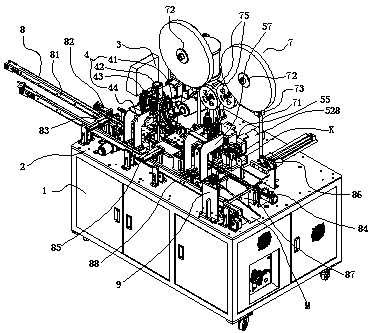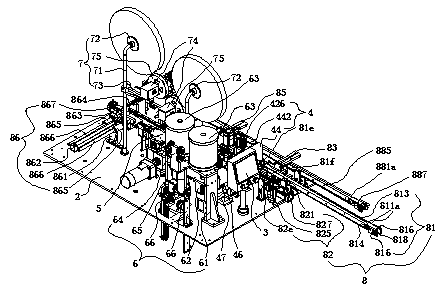[0002]
Relay (English name: relay) is an
electrical control device, which is an electrical appliance that causes the controlled quantity to undergo a predetermined step change in the electrical output circuit when the change of the input quantity (excitation quantity) meets the specified requirements. It is an "automatic switch" that uses a small current to control the operation of a large current, so it plays the role of automatic adjustment, safety protection, conversion circuit, etc. in the circuit; in the production process of traditional relays, the wires or wires are generally manually adjusted manually. Conductive terminal welding, this welding method is inefficient. During the
welding process, the required current is large and the temperature is high. Manual operation is easy to touch the welding part during the welding operation, so that the operator may get an
electric shock or Accidents such as burns
pose great safety hazards to operators; and manual welding is prone to problems such as welding position deviation, improper welding strength, too short or too long welding time, etc., so that the welding position of the wire is not correct, If the wire welding is not stable or the welding position of the terminal is burnt, the
yield rate of the product is low; During the pick-up process, it is easy to tear off the just-welded wire from the conductive terminal, which affects the
processing effect and
yield rate of the product; after removing the item, it is necessary to recycle the jig and move it to the beginning of the
production line for
backup, which is time-consuming and laborious
[0003] With the development of science and technology, people's ability to research and develop equipment continues to improve, which makes the
automation process of production and processing more and more improved. The emergence of resistance welding machines replaces manual hand-held operations and ensures the personal safety of operators. However, the existing resistance welding
machine The structure of the welding machine is relatively complicated, which is not convenient for daily maintenance; moreover, the welding head /
electrode generating end of these resistance welding machines is generally flat because the bottom surface is generally flat, and the welding head /
electrode generating end is easy to crush the wire or damage the terminal during the welding operation. Affect the
yield rate of products, such as the patent of a resistance welding machine disclosed in the announcement number CN207139092; and, in the production process, the wires are generally
cut to length manually, and then the
insulation layer at least one of the ends is stripped , and then move to the next process for welding operations. This method is inefficient, time-consuming and laborious. Moreover, in the process of manual stripping, it is easy to damage the conductors in the wires and affect the quality of the product, so that the defective rate of the product is high; With the development of science and technology, the emergence of automatic
wire cutting and stripping equipment, although the efficiency of
wire cutting and stripping has been improved to a certain extent, and the conductor of the wire is avoided during stripping, but such equipment is generally independent of the equipment in the
welding process. After the cutting and stripping is completed, it is still necessary to manually transfer the wires to the position of the welding
process equipment for the next
process operation. The connection between the processes is not smooth, which still affects the efficiency. Moreover, the
cut and stripped wires are generally scattered in the storage Box / storage box, it is inconvenient for the operator to take the wire, which still limits the processing efficiency of the product
[0004] In addition, in the process of terminal welding, because the materials to be welded (such as conductive terminals) often have leftovers connected, the materials need to be
cut off from these leftovers, and then manually transferred to the next process for further processing. The processing, the connection between the process and the process is not smooth, the degree of coordination is low, time-consuming and labor-intensive, and the efficiency is low; in addition, the cut wires are prone to different degrees of wire body bending, which limits the
automation of welding operations to a certain extent.
 Login to View More
Login to View More  Login to View More
Login to View More 


